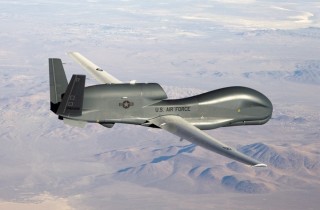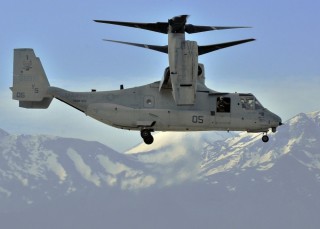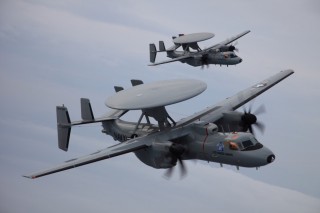Loading
Search
▼ Tiltrotors, Radar Planes, Spy Drones and Amphibious Vehicles — Japan Goes on a Buying Spree
- Category:Other

MEDIUM
On Nov. 20, Japan’s ministry of defense announced it would buy billions of dollars’ worth of American-made aircraft and vehicles, including high-tech V-22 Osprey tiltrotors and the latest RQ-4 Global Hawk spy drones.
The new weapons are part of Tokyo’s evolving strategy for deterring—and potentially fighting—China’s increasingly aggressive armed forces in the Western Pacific.
In addition to the Global Hawks, the Japan Air Self-Defense Force will get E-2D Advanced Hawkeye radar early-warning planes. The V-22s will belong to the Ground Self-Defense Force, as will a new fleet of AAV7 amphibious vehicles.
The Hawkeyes fit into Japan’s existing defense plans. But the Ospreys, Global Hawks and AAV7s represent new capabilities. The Self-Defense Force wants these new systems to help it respond to China’s military activities along Japan’s southwestern sea border.
Aerial radar showdown
Northrup Grumman’s E-2D beat out a Boeing 737-based radar plane in the contest for Japan’s next airborne early warning and control platform.
The Japanese trading powerhouse Itochu submitted the bid for the Boeing aircraft. Defense officials noted the superior cruising range and on-board capabilities of the Itochu bid, but chose the U.S. government’s E-2D bid as the cheaper purchase—¥14.4 billion per aircraft, or $122 million.
The Advanced Hawkeye will begin replacing the Air Self-Defense Force’s 13 E-2Cs, which entered service in 1987. Japan began upgrading its E-2Cs to the more sophisticated Hawkeye 2000 model in 2005.
The Advanced Hawkeye can stay in the air longer than its predecessor. It boasts new engines, a better avionics suites and a more sensitive electronically-scanned UHF radar for improved target detection and tracking.
Its processing and communications package is compatible with Japan’s existing Aegis Ballistic Missile Defense system.
The Ministry of Defense plans to have four E-2D by the end of the 2019 fiscal year. The first will enter service at Naha air base in 2016 or 2017. The U.S. Navy began using Advanced Hawkeyes this year—Tokyo will undoubtedly be watching the aircraft’s performance very carefully.

Tiltrotor turnaround
The Ministry of Defense tailored a request for tender specifically for the V-22 after the government, late last year, signaled its interest in purchasing 17 Ospreys from the U.S.
The unique aircraft, which takes off and lands like a helicopter but cruises like an airplane thanks to its rotating engines—is already in Japan’s Okinawa prefecture with the resident U.S. Marine Corps.
The V-22 has a history of fatal crashes that has colored local opinion. There have been protests over the Osprey’s deployment to Japan—not just in Okinawa, but also in areas under the tiltrotors’ flight paths.
The Osprey’s bad reputation is hard to shake. Tokyo has been trying to dispel local people’s worries by encouraging the Americans to fly their Ospreys over the Japanese main islands—thus proving that the tiltrotors can be safe.
In October, V-22s took part in the army’s Michinoku ALERT exercise in the Tohoku region as well as in a tsunami drill. In both exercises, they ferried medical teams and emergency supplies into the supposed disaster-stricken regions.
The Osprey has also been a crowd-pleaser at recent American and Japanese military airshows.
The Ministry of Defense has been in talks with local authorities in Saga prefecture, where it hopes to base Japan’s Osprey fleet—and it seems like the public relations war is paying dividends.
The prefectural governor appears willing to allow the V-22s to fly out of Saga’s commercial airport. The airport is strategically important—it’s close enough to Sasebo to ferry the planned amphibious force there to the nation’s outlying Nansei islands in order to defend against incursions by rivals such as China.

Unmanned surveillance
The U.S. government placed both bids for Japan’s requirement for a long-endurance unmanned aerial vehicle. Northrup Grumman’s Global Hawk won out over General Atomics’ Guardian ER.
Defense officials will request ¥100 billion from next year’s budget to purchase three aircraft by 2018. The aircraft should enter service the following year.
The ministry first mentioned its concrete plans to pursue the Global Hawk last year when it appropriated ¥200 million to research a possible acquisition.
Japan has expressed an interest in the huge spy drone since the 2011 tsunami. The U.S. sent its own RQ-4 from Guam to conduct aerial damage assessment over the disaster-stricken regions.
Tokyo is currently considering deploying Japan’s Global Hawks out of Misawa air base in Aomori. The U.S. Air Force began operating Global Hawks out of the same base this summer.
Like the U.S. drones at Misawa, Tokyo’s Global Hawks will likely keep watch on North Korean missile activity and on the Chinese military and civilian activity encroaching on Japan’s southwestern border.
For an island nation such as Japan with large expanses of ocean between its air bases and maritime borders, the Global Hawk’s 28-hour flight time make it an ideal surveillance platform—although critics warn that three aircraft is simply not enough to provide continuous uninterrupted surveillance.
- November 25, 2014
- Comment (0)
- Trackback(0)

